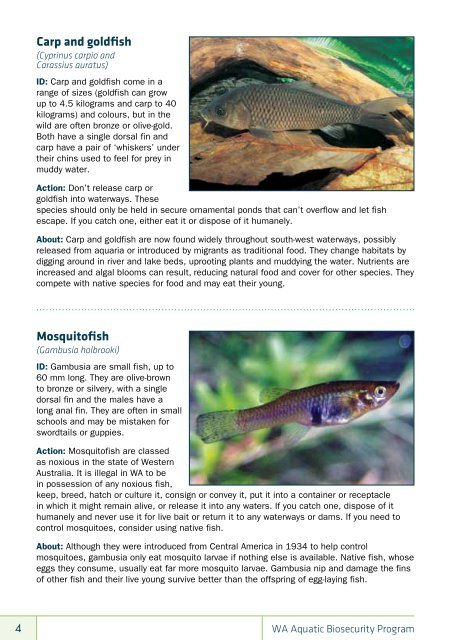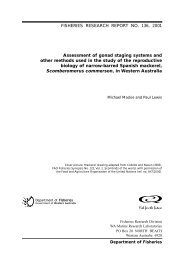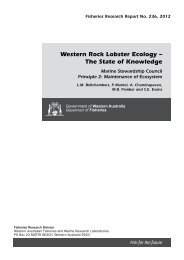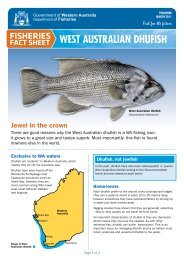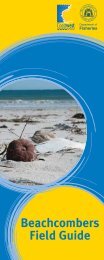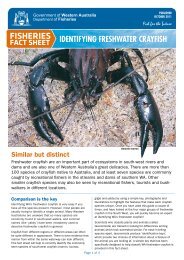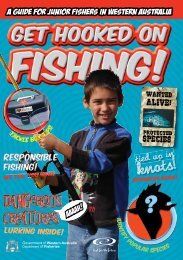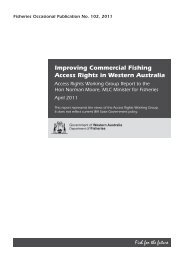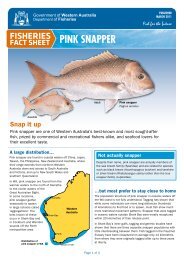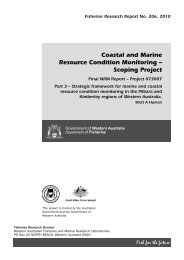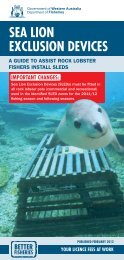aquatic invaders identification guide - Department of Fisheries
aquatic invaders identification guide - Department of Fisheries
aquatic invaders identification guide - Department of Fisheries
Create successful ePaper yourself
Turn your PDF publications into a flip-book with our unique Google optimized e-Paper software.
4<br />
Carp and goldfish<br />
(Cyprinus carpio and<br />
Carassius auratus)<br />
ID: Carp and goldfish come in a<br />
range <strong>of</strong> sizes (goldfish can grow<br />
up to 4.5 kilograms and carp to 40<br />
kilograms) and colours, but in the<br />
wild are <strong>of</strong>ten bronze or olive-gold.<br />
Both have a single dorsal fin and<br />
carp have a pair <strong>of</strong> ‘whiskers’ under<br />
their chins used to feel for prey in<br />
muddy water.<br />
Action: Don’t release carp or<br />
goldfish into waterways. These<br />
species should only be held in secure ornamental ponds that can’t overflow and let fish<br />
escape. If you catch one, either eat it or dispose <strong>of</strong> it humanely.<br />
About: Carp and goldfish are now found widely throughout south-west waterways, possibly<br />
released from aquaria or introduced by migrants as traditional food. They change habitats by<br />
digging around in river and lake beds, uprooting plants and muddying the water. Nutrients are<br />
increased and algal blooms can result, reducing natural food and cover for other species. They<br />
compete with native species for food and may eat their young.<br />
Mosquit<strong>of</strong>ish<br />
(Gambusia holbrooki)<br />
ID: Gambusia are small fish, up to<br />
60 mm long. They are olive-brown<br />
to bronze or silvery, with a single<br />
dorsal fin and the males have a<br />
long anal fin. They are <strong>of</strong>ten in small<br />
schools and may be mistaken for<br />
swordtails or guppies.<br />
Action: Mosquit<strong>of</strong>ish are classed<br />
as noxious in the state <strong>of</strong> Western<br />
Australia. It is illegal in WA to be<br />
in possession <strong>of</strong> any noxious fish,<br />
keep, breed, hatch or culture it, consign or convey it, put it into a container or receptacle<br />
in which it might remain alive, or release it into any waters. If you catch one, dispose <strong>of</strong> it<br />
humanely and never use it for live bait or return it to any waterways or dams. If you need to<br />
control mosquitoes, consider using native fish.<br />
About: Although they were introduced from Central America in 1934 to help control<br />
mosquitoes, gambusia only eat mosquito larvae if nothing else is available. Native fish, whose<br />
eggs they consume, usually eat far more mosquito larvae. Gambusia nip and damage the fins<br />
<strong>of</strong> other fish and their live young survive better than the <strong>of</strong>fspring <strong>of</strong> egg-laying fish.<br />
WA Aquatic Biosecurity Program


